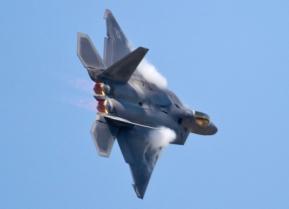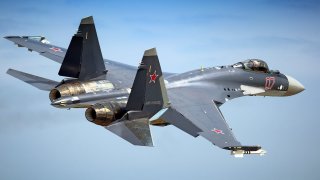Su-35: Russia's 'Best Fighter' Jet in Ukraine Is No Game Changer
Russia’s fleet of fourth-generation Su-35 fighter jets have monopolized headlines since the invasion of Ukraine. But for all of the wrong reasons.
Russia’s fleet of fourth-generation Su-35 fighter jets have monopolized headlines since the invasion of Ukraine.
However, these “cutting-edge” airframes have garnered attention primarily for negative reasons.
Industry experts and analysts widely concur that Moscow’s top-of-the line platform has not performed as expected in combat.
Nonetheless, an Su-35 fighter was scrambled over the Baltic Sea back in March to confront two U.S. strategic bombers veering towards the border. Although the two bombers ultimately flew away, Russia’s defense ministry said it sent the Su-35 jet over to “prevent a border violation.”
Considering the jets’ lackluster track-record so far in combat, perhaps the remaining Su-35 fighters would be best put to use monitoring the border.
A brief overview of the Su-35 fighter
During the Cold War, the Russian defense company Sukhoi was tasked with developing a supermaneuverable airframe that could go up against America’s own fleet of fourth-generation fighters. The McDonnell Douglas F-15 Eagle and Grumman F-14 Tomcat were particularly threatening to the Soviet Union’s aging arsenal of jets.
The Su-35 became the designation for two improved variants of the older Su-27 air-defense fighter platform. By the late 1980’s, the first Su-35 prototype (formerly known as the Su-27M) took its maiden flight.
Over the years, the Su-35 underwent various facelifts to modernize its capabilities.
Today, the jet is dubbed the “Flanker-E” by the North Atlantic Treaty Organization (NATO). According to the airframe’s manufacturer the United Aircraft Corporation (UAC), the jet “combines the qualities of a modern fighter (super-maneuverability, superior active and passive acquisition aids, high supersonic speed and long range, capability of managing battle group actions, etc.) and a good tactical airplane (wide range of weapons that can be carried, modern multi-channel electronic warfare system, reduced radar signature, and high combat survivability).”
The improved variant of the Su-35 sports thrust-vectoring engines in place of canards, which enables the plane to gain air supremacy by destroying UAVs with missiles at any range while simultaneously carrying out both long-range and short-range maneuvers.
Additionally, the fighters’ twin Saturn AL-41F1S turbofans provide it with the supermaneuverability that the UAC claims can easily match or even exceed the techniques of near-peer fourth-generation platforms.
The Su-35 Flanker-E Has Not Performed Well in Ukraine
On paper, the Su-35 could be getting the job done in Ukraine for the Kremlin. However, several flaws associated with the airframe has limited its performance.
Moscow has struggled to export the pricey jets. Due to The Counter America’s Adversaries Through Sanctions Act, many potential foreign clients have refused to procure the fourth-generation fighter.
Additionally, the construction of Flanker-Es incorporates Western parts and equipment, which has become increasingly difficult for Moscow to acquire amidst recently imposed economic sanctions.
Since the outbreak of the war, Russia is estimated to have lost dozens of airframes, according to the commander of U.S. Air Forces in Europe Gen. James Hecker. While the exact number of downed Flanker-E jets remains unclear, there have been confirmed reports of at least several losses.
The Su-35 may not be as formidable as the Kremlin likes to propagate.
However, the fourth-generation fighter remains a significant component to Russia’s aerial abilities.
Maya Carlin is an analyst with the Center for Security Policy and a former Anna Sobol Levy Fellow at IDC Herzliya in Israel. She has by-lines in many publications, including The National Interest, Jerusalem Post, and Times of Israel.
Image: Creative Commons.


